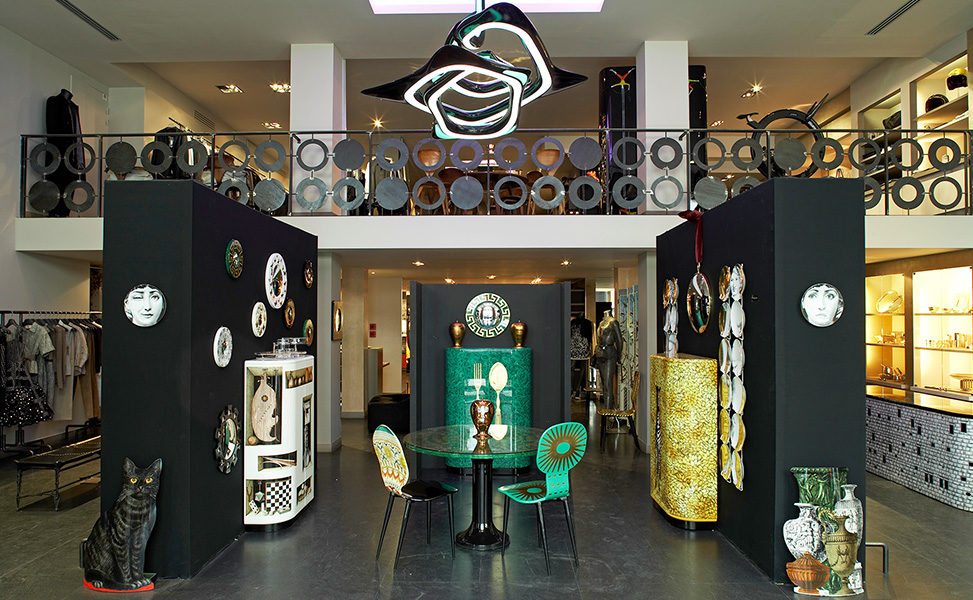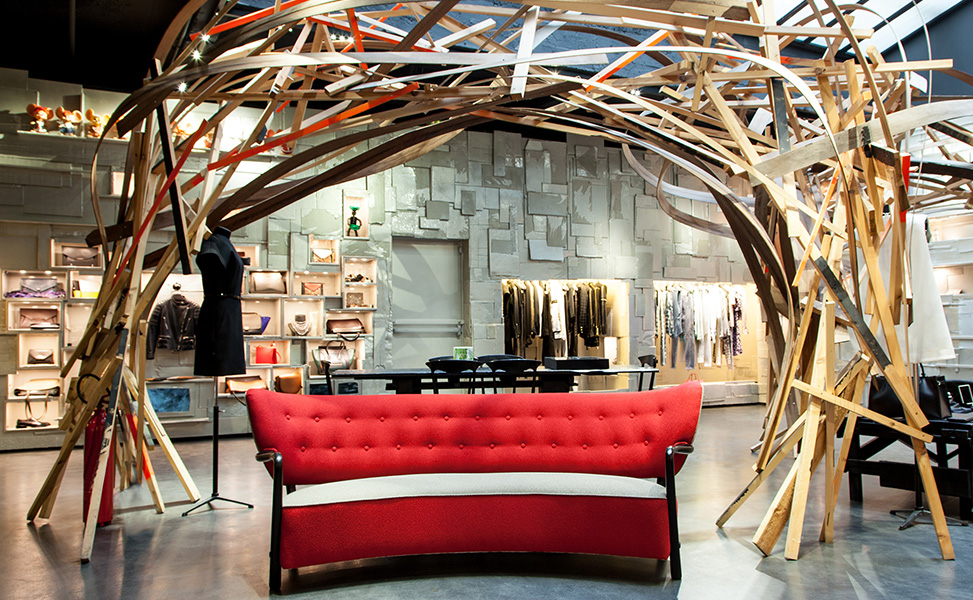PARIS BETWEEN FASHION AND DESIGN
Un viaggio a Parigi – la città che ha ispirato i colori e le sceneggiature dei set design ideati da Studio MILO per le ultime tre campagne dedicate alla moda, ai gioielli e alla casa – alla scoperta dei luoghi fonti di creatività per Arianna Crosetta e Federica Gosio, fondatrici dello studio con base a Milano e Londra.
IS PARIS STILL THE CREATIVITY CAPITAL?
WORLD IS CHANGED, BOTH IN FASHION AND DESIGN.
Monsieur Armand Hadida – fondatore della storica boutique L’Eclaireur – intervistato per Studio MILO Magazine, Fall Issue.
SM: Signor Hadida, lei è uno dei pionieri per la Moda e per il Design a livello internazionale, sia dal punto di vista della creatività che nello sviluppo di un modello di business. Cosa significa oggi essere un pioniere e che cosa è cambiato?
AH: la cosa più difficile oggi è comprendere le regole della comunicazione e del mercato e di come si rivolge al consumatore finale. Capire e interpretare le difficoltà legate alla velocità di come le nuove tecnologie trasformino le nostre abitudini. Oggi è importante essere presente con la personalizzazione e la valorizzazione del singolo, dell’individuo. Esprimere un senso autentico di originalità per sorprendere. Il consumatore contemporaneo è informato, sa scegliere, è capace di trovare la sua singolarità, attingendo da ciò che più gli corrisponde. Come uno chef in cucina: un menù è fatto dai sapori, dai colori e dagli ingredienti speciali che sappiamo mettere in una ricetta che ricerchiamo con cura. La vera difficoltà dei nostri tempi è che, in generale, tutti vogliono la stessa cosa. I media in questo hanno un ruolo fondamentale nel proporre – attraverso la pubblicità, le riviste, eccetera – un modello che il consumatore vuole imitare. Quindi ricercare ed esprimere una unicità, oggi è il lavoro più difficile.
SM: Quanto l’architettura e il design hanno un ruolo nei negozi che lei ha aperto nel mondo e in generale? Come riesce a combinare e condividere le idee per arrivare a così grandi risultati?
AH: L’architettura oggi è uno degli aspetti importanti nella creazione di un luogo. L’abilità sta nel saper integrare il contenuto alla forma, come in tutte le cose. Saper creare una simbiosi perché il cocktail funzioni. Da sola l’architettura non può funzionare, occorre la combinazione multipla dei vari aspetti e funzioni. Grazie ai media, l’architettura si è sempre più democratizzata: oggi tutti conosciamo e riconosciamo i nomi dei grandi architetti, prima era assolutamente confidenziale. Tutto dipende da come si voglia utilizzare l’architettura. Se è un elemento di immagine, bene, l’architettura da sola può bastare, ma se c’è di mezzo il commercio l’architettura da sola non è sufficiente.
SM: Cosa rappresenta per le la parola Lusso? Cosa significa oggi?
AH: La traduzione della parola lusso si è completamente trasformata. Il lusso è qualcosa che si riferisce alla segretezza del bene, qualcosa che non si può scoprire, né riconoscere. Non è più un concetto banale, è singolarità, qualcosa di raro e prezioso.
SM: Il mondo sta cambiando. Ora il web sta crescendo sotto ogni punto di vista. Le piace? Pensa ci sia qualche debolezza dietro a questo sistema?
AH: Il web è qualcosa di magico perchè è veramente alla portata di tutti e non possiamo più vivere senza. È stato il primo veicolo di democratizzazione della moda e sarà sempre più importante. Però l’emozione è possibile grazie alla relazione con le persone: nei negozi abbiamo una dimensione emotiva che solo grazie al rapporto personale ed esperienziale con gli spazi e le cose, diventa unica e importante. La dimensione fisica non smetterà mai di essere il vero ambasciatore della creatività.
SM: Parigi è un punto di riferimento per la moda, l’architettura e la cultura. Come vede questa città?
AH: Parigi e Roma sono due città incredibili che vivono di storia e cultura. Qui si trovano le vere emozioni. Bisogna però attingere all’innovazione per mantenere e meritarsi i primati di città più belle al mondo.
SM: Quanto tempo passa in questa città e cosa le piace di più?
AH: Passo a Parigi la metà del mio tempo. Quel che più mi affascina è la Senna. È la natura in movimento, adoro guardare il fiume che scorre e attraversa l’intera città. Anche i monumenti di Parigi e le sue architetture sono stupende. Ma sono ferme e statiche. E poi c’è la dimensione elementare: l’acqua, che è l’elemento di cui siamo composti…
—
PARIS BETWEEN FASHION AND DESIGN
Paris – the city that has influenced the colours and back drops of the latest set design – always represents a source of inspiration for Arianna Crosetta and Federica Gosio, founders of Studio MILO with bases in Milan and London.
IS PARIS STILL THE CREATIVITY CAPITAL?
WORLD IS CHANGED, BOTH IN FASHION AND DESIGN.
Monsieur Armand Hadida – founder of the historic boutique L’Eclaireur interviewed for Studio Milo Magazine – Fall Issue.
SM: Mr. Hadida, you are one of the pioneers for Fashion and Design at an international level, both from the point of view of creativity and development of a business model. What does it mean today to be a pioneer and what has changed?
AH: the most important thing today is understanding the rules of communication and the market and how it addresses the final consumer. Understanding and interpreting the difficulties associated with the speed of how new technologies transform our habits. Today, it’s important to be present with the personalisation and valorisation of the single individual. Expressing an authentic sense of originality to surprise. Contemporary consumers are informed, know how to choose, and are able to find their singularity, drawing from what best suits them. Like a chef in the kitchen: a menu is made of flavours, colours, and special ingredients that we manage to put in a recipe that we research with care. The real difficulty of our times is that, in general, everyone wants the same thing. The media, in this, have a key role in proposing – through advertising, magazines, and so on – a model that the consumer wants to imitate. Thus, seeking and expressing uniqueness is the hardest job today.
SM: How much of a role do architecture and design play in the stores you opened in the world and in general? How do you manage to combine and share the ideas to achieve such great results?
AH: Architecture today is one of the important aspects in the creation of a place. The skill lies in knowing how to integrate content into form, like in all things. Knowing how to create a symbiosis to make the cocktail work. Architecture alone cannot work; the multiple combination of the various aspects and functions is needed. Thanks to the media, architecture has become increasingly democratised: today we all know and recognize the names of the great architects, while in the past it was absolutely confidential. It all depends on how you want to use architecture. If it’s an element of image, then sure, architecture alone can suffice, but if commerce is involved, architecture alone is not enough.
SM: What does the word luxury mean to you? What does it mean today?
AH: The translation of the word luxury has been transformed completely. Luxury is something that refers to the secrecy of the good, something that cannot be discovered, nor recognised. It’s no longer a banal concept, it’s singularity, something rare and precious.
SM: The world is changing. Now the web is growing from every point of view. Do you like it? Do you think there is some weakness behind this system?
AH: The web is something magical because it really is within the reach of everyone and we can no longer live without it. It was the first vehicle for the democratisation of fashion and will be more and more important. But emotion is possible thanks to the relationship with people: in the stores we have an emotional dimension that only thanks to the personal and experiential relationship with the spaces and things becomes unique and important. The physical dimension will never cease to be the true ambassador of creativity.
SM: Paris is a point of reference for fashion, architecture, and culture. How do you see this city?
AH: Paris and Rome are two incredible cities that live of history and culture. Here is where you find the real emotions. But we must draw on innovation to keep and deserve the titles of most beautiful cities in the world.
SM: How much time do you spend in this city and what do you like the most?
AH: I spend in Paris half of my time. What most fascinates me is the Seine. It’s nature in motion; I love watching the river flowing through the whole city. Even the monuments of Paris and its architecture are wonderful. But they are immobile and static. And then there’s the elemental dimension: water, which is the element we are made of…
www.leclaireur.com


